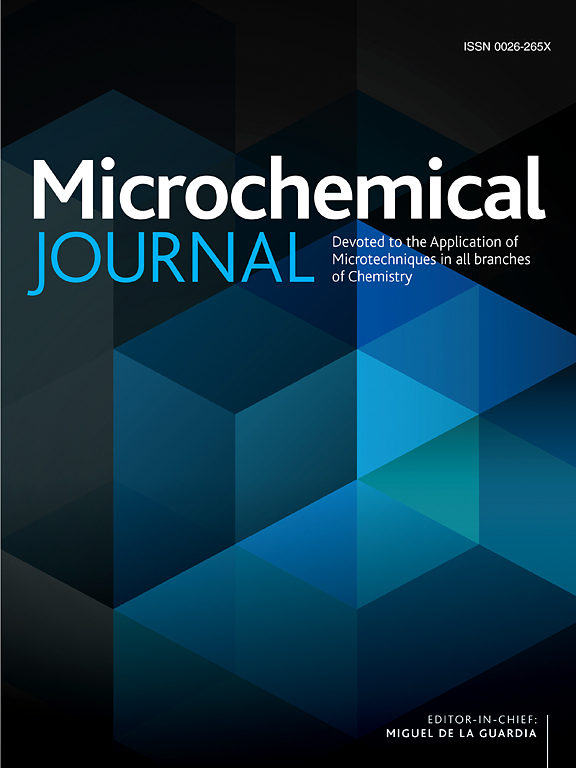基于多肽的荧光探针具有大斯托克斯位移,可用于特异性连续检测铜 (II) 离子和组氨酸:智能手机设备、真实样品、试纸和生物成像应用
IF 4.9
2区 化学
Q1 CHEMISTRY, ANALYTICAL
引用次数: 0
摘要
基于丹酰荧光团标记的二肽骨架(Asn-His-NH2),开发出了一种新型简便的荧光探针 DNH。基于顺磁淬灭机制,DNH 在检测 Cu2+ 方面表现出明显的优势,包括令人满意的水溶性(100% 水介质)、较大的斯托克斯位移(230 nm)、出色的抗干扰能力(无干扰)、较低的检测限(19.6 nM)、快速响应时间(30 秒内)和较宽的 pH 值范围(7-12)。采用置换方法,DNH-Cu2+ 组合在识别 L-His 时显示出强烈的荧光增强,具有出色的选择性,DNH-Cu2+ 组合对 L-His 的检测限为 22.8 nM。值得注意的是,当交替添加 Cu2+ 和 L-His 时,DNH 显示出良好的可逆性,至少可持续七个周期,且荧光强度变化不大。此外,DNH 还具有极低的细胞毒性和良好的生物相容性,可作为一种出色的探针,用于在活细胞和斑马鱼中连续测定 Cu2+ 和 L-His。DNH 成功用于测定三种实际水样中的 Cu2+ 和 L-His,回收率高,准确度好。此外,还将 DNH 应用于滤纸,开发出了快速高效分析 Cu2+ 和 L-His 的可视试纸。此外,通过将智能手机的颜色识别器开发成便携式分析设备,实现了对 Cu2+ 和 L-His 的半定量视觉监测,检出限分别低至 0.49 μM 和 0.63 μM。鉴于这些特性,DNH 是一种很有前途的肽基荧光探针,在各种环境和生物环境中对 Cu2+ 和 L-His 进行实时可视监测方面具有很大的潜力。本文章由计算机程序翻译,如有差异,请以英文原文为准。

Peptide-based fluorescent probe with large Stokes shift for specific sequential detection of copper (II) ions and histidine: Smartphone device, real samples, test strips and bioimaging applications
A novel and facile fluorescent probe, DNH, was developed based on a dipeptide backbone (Asn-His-NH2) labelled with a dansyl fluorophore. DNH exhibited significant advantages in detecting Cu2+ based on the paramagnetic quenching mechanism, including satisfactory water solubility (100 % aqueous medium), a large Stokes shift (230 nm), excellent anti-interference capability (no interference), a low detection limit (19.6 nM), rapid response time (within 30 s) and a wide pH range (7–12). Employing a displacement approach, the DNH-Cu2+ ensemble showed strong fluorescence enhancement upon recognition of L-His with outstanding selectivity, and the detection limit for the DNH-Cu2+ ensemble with respect to L-His was calculated at 22.8 nM. Notably, DNH demonstrated favourable reversibility for at least seven cycles with minor changes in fluorescence intensity when Cu2+ and L-His were added alternately. Moreover, DNH exhibited excellent low cytotoxicity and good biocompatibility, and was utilised as an outstanding probe for the sequential determination of Cu2+ and L-His in living cells and zebrafish. DNH was successfully used to determine Cu2+ and L-His in three actual water samples with good recovery and accuracy. In addition, DNH was applied to filter paper to develop visual test strips for the rapid and high-efficiency analysis of Cu2+ and L-His. Furthermore, the semi-quantitative visual monitoring of Cu2+ and L-His was achieved by developing a smartphone colour recogniser into a portable analytical device, achieving low detection limits of 0.49 μM and 0.63 μM, respectively. Given these attributes, DNH presents itself as a promising peptide-based fluorescent probe, showcasing considerable potential for real-time visual monitoring of Cu2+ and L-His in various environmental and biological settings.
求助全文
通过发布文献求助,成功后即可免费获取论文全文。
去求助
来源期刊

Microchemical Journal
化学-分析化学
CiteScore
8.70
自引率
8.30%
发文量
1131
审稿时长
1.9 months
期刊介绍:
The Microchemical Journal is a peer reviewed journal devoted to all aspects and phases of analytical chemistry and chemical analysis. The Microchemical Journal publishes articles which are at the forefront of modern analytical chemistry and cover innovations in the techniques to the finest possible limits. This includes fundamental aspects, instrumentation, new developments, innovative and novel methods and applications including environmental and clinical field.
Traditional classical analytical methods such as spectrophotometry and titrimetry as well as established instrumentation methods such as flame and graphite furnace atomic absorption spectrometry, gas chromatography, and modified glassy or carbon electrode electrochemical methods will be considered, provided they show significant improvements and novelty compared to the established methods.
 求助内容:
求助内容: 应助结果提醒方式:
应助结果提醒方式:


